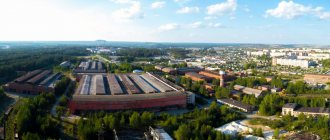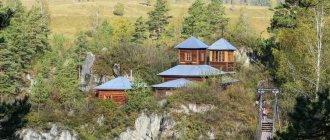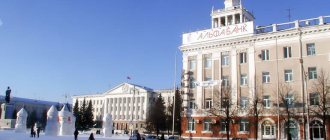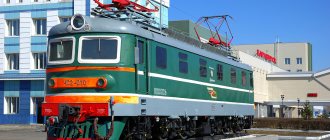The city of Yasny, the administrative center of the Yasnensky district, is located 150 km from Orsk, 28 km from the Razvedka railway station and 3 km from the Gorny Len railway station. Founded in 1961 in connection with the discovery of the Kiembaevsky asbestos deposit and the construction of the Orenburgasbest mining and processing plant. City since 1979
Back in the 30s, near the village of Kiembay, which translated from Kazakh means “rich clothes,” asbestos deposits were discovered. However, the war prevented the completion of the survey work.
In general, the first studies of the territory of the future field date back to the end of the 18th and the first half of the 19th century, when P.S. visited here. Pallas in 1773, Kovalevsky, Gengro, Eversman, Murchison in 1840, Meglitsky and Antipov in 1854-1855.
In 1932-1933, employee of the Volga Geological Trust A.A. Petrenko carried out a geological survey of the Eastern Orenburg region over an area of 10 thousand square kilometers and laid the foundation for a consistent study of the geology and minerals of this area.
In 1935, the first geological survey work on the territory of the Kiembaevskoye field was carried out by B.I. Borsuk, who discovered asbestos outcrops on the earth's surface. In 1941, on the eve of the Great Patriotic War, a group of geologists was sent here, to the east of the Orenburg region, and began a specialized search for a rare mineral. Soon one of the geologists, V.I. Shcherbina, discovered silky fibers in the “dump” of a marmot hole. And soon, after persistent searches, in the area of \u200b\u200bMount Dusbaika, near the village of Verkhniy Kiembay, Shcherbina found serpentinite rock coming to the surface - a constant companion of asbestos.
It should be noted that B.I. Borsuk, and V.P. Shcherbina were somewhat skeptical about the future asbestos deposit. Nevertheless, their work, as well as that of other geologists, subsequently contributed to the discovery of the Kiembaevsky chrysotile asbestos deposit.
In 1952, the first post-war search party was led by experienced geologist V.R. Artemov, Doctor of Geological and Mineralogical Sciences. The initiative to organize the search work belonged to the chief engineer of the Soyuzgeologoasbest trust A.S. Chernikov. The prospecting project was drawn up by V.R. Artemov.
A.S. participated in the first familiarization route to the Kiembaevsky massifs, from which the discovery of the deposit began. Chernikov, head of the search team V.R. Artemov, Head of Dzhetygarinskaya GRP D.L. Rykulin. Soon the “Glavnaya” deposit was discovered and asbestos rocks were discovered in the area, which later received the name “Northern”.
In the spring of 1953, the first wells began to be drilled and seals were collected from various depths. Among the first drillers were N.I. Shlyakhtin, P.P. Akimenko, G.K. Anferov. Drilling aces, they passed on their experience to the young. Soon the young people also became real masters of drilling - P. Pasechnik. A.M. Beauty, B. Sarsembayev, V.A. Tkalich, A. Kikinev, M.D. Koksharov, L. Heide, I. Savelyev...
Simultaneously with the exploration of asbestos deposits, housing construction was already underway in the summer of 1953. The first homes of the pioneers were dugouts with windows looking into the sky. It was later that houses built of adobe, reed slabs or turf appeared. Heating is a potbelly stove and stoves, water from a well or a water heater, bread from Kumak. It wasn't easy for the pioneers, especially by today's standards. But none of them complained, but on the contrary, each tried to make the greatest contribution to the common cause. Having finished their shift in the mountain area, people went to build barracks and unload the arriving cargo. It was through their efforts that the necessary basis was created for the continuation of exploration work, the scope of which was increasing every month.
The village of Razvedchik is remembered with great warmth by its residents. According to them, they were one family. The doors of the houses were never locked. If a wedding happened, the whole village celebrated, everyone could come to it. There was a village club, headed by M.M. Beauty. People still remember the amateur performances, the choir and one of its soloists, Konstantin Nikolaevich Trushkovsky.
From 1954 to 1960, the work of the Kiyemba geological party was headed by geologist A.P. Stepanov, under whose leadership detailed exploration to a depth of 400 meters was completed, a project of conditions for the deposit was drawn up and approved, and asbestos reserves of the Main site were calculated. In 1959, the deposit was registered with the State Reserves Committee. But exploration work at the new field continued and lasted for more than 20 years from the moment of its discovery.
...June 1961. By decree of the Council of Ministers of the RSFSR and the Orenburg Economic Council, the Asbeststroy construction trust was formed for the construction of the plant and workers' village and the directorate of the plant under construction was created. Vladimir Pavlovich Muromtsev was appointed its first director.
The first construction manager was Alexander Vladimirovich Chernomazenko. He was a demanding person, but fair, easy to deal with people, not a hint of arrogance or arrogance, did not tolerate falsehood, the desire to “get out”, or shift the blame for omissions from himself. He cared about people, respected their opinions, saw people, people did not dissolve for him in the general mass.
There was no hospital at that time, and the conditions were not easy. People started getting sick. Housing is also tight. And yet they decided to sacrifice housing. Four houses were given over to a pharmacy, an outpatient clinic and a hospital. And Chernomazenko was reprimanded for “wasting housing.”
Tents, potbelly stoves, water from a tank, dirt in autumn and spring, Orenburg snowstorms known for their indomitability in winter and dust storms in summer. Work until you sweat, in the wind, in the heat and cold, endless subbotniks and sundays - this is how Yasny began, it began with people...
In the work book of M.M. Minnikhaziev, the date of entry for employment in SU-31 of the Asbeststroy trust is July 14, 1961. On his first working day, he, together with F. Yusupov and Y. Mazitova, went to Orsk, they brought about 200 tents in 3 cars, each of them was designed for 20 people. The first tent was erected on the site of the former music school building. And two tents were already standing here, they were, as it were, erected without permission, private tents, and the guys who had arrived from Svetly lived in them - Sergei Dovzhenok, Pavel Dolzhin and Svetlana Povolokina. A few days later, a tent city grew up in the steppe. He was waiting for his tenants. And they began to arrive. These were envoys from Orenburg, Smolensk, Voronezh, Ulyanovsk regions, Belarus, Chuvashia, and Mordovia. Young boys and girls went to continue their fathers’ work biographies and write their own. They named the streets in the tent city, and then in the village under construction, in memory of their native places - Moldavskaya, Voronezhskaya, Orenburgskaya...
A tent city grew; in the fall of 1961, about 3,000 construction workers lived in 150 tents. No matter how hard they tried to build housing faster, they lived in tents throughout the fall and winter. The last tent was removed on February 28, 1962. They spent the winter without their families. And only one of the builders brought with him his family - his wife and four children, the youngest of them was not even two years old. It was Fayzulhak Yusupov. He worked first as a groom, then as a carpenter.
The first team leaders immediately stood out with their ability to organize people and create a businesslike spirit: Vasily Bulygin, Vadim Krivoshein, Alexander Pashnin, Mikhail Doktorovich. The first builders were in a fighting mood; they often worked from 6-7 in the morning until 11 at night. And they didn’t complain about boredom. No matter how tired they were, they found time and energy for sports and amateur activities. The first dance floor was on the site of the current parking lot on the street. Ural. Here the first projectionist and photographer of Yasny L.V. “played the movie”. Kripak.
Then the first club was built - A. Pashnin’s team installed it in one day. Later, by order of Chernomazenko, 3 houses were converted into a club.
Already in 1962, their own orchestra appeared, instruments were donated by the residents of Novotroy, they also brought a library - about 300 books. The football team was strong, coached by SU-32 mechanic Valentin Babin. And the team of hockey players was trained by N.A. Goncharov. In 1962, Yasny athletes went to Orenburg for the first time to regional competitions and brought 4 cups for prizes. The first Komsomol youth leader is Sasha Novikov. The mood of the volunteers who came to build the city, to test themselves, is understandable.
During the first year, several amenities were built in the village. In the spring, a kindergarten with 25 places was opened, and on September 1, the school, which in October 1964 moved to a new standard building with excellent classrooms and a gym. Its first teachers were T.I. Goncharova, I.I. Kurteeva, L.P. Kozina, L. Ya. Kolesnik, 3.M. Bannikova, E.F. Chernyaeva, A.I. Kosenok.
In parallel with the construction of housing, builders created their own base. The first to operate was a small concrete plant, where several concrete mixers were installed on temporary foundations. Later, workshops and warehouses were built for the trust and subcontractors, a standard garage for the construction fleet and a power plant building. Well No. 82, drilled by geologists, was connected to Yasny by a kilometer-long water supply system. At that time, the village maintained communication with the outside world using a walkie-talkie.
In 1962, the settlement under construction was named Yasny. In 1963, a village Council of Workers' Deputies was created in Yasny. The first chairman of the executive committee of the council was E.S. Silantyev, Deputy Chairman P.V. Fursov, secretary of the executive committee N.V. Frolova. By this time there were already more than three thousand inhabitants. Construction of the second microdistrict has begun. Unlike the first one, there were no barracks or two-story houses. It was built up with five-story residential buildings. A canteen, a kindergarten, shops, and a library were opened in the microdistrict.
Along with housing and cultural facilities, industrial construction was carried out. The bakery, commissioned in 1963, became the first industrial enterprise in Yasny. In the summer of the same year, they began to lay the foundations for the buildings of the processing complex.
In 1964, the construction of the IV crushing stage building began, in 1965 - buildings of the I, II and III crushing stages, and a dry ore warehouse. Boris Nikolaevich Tokmantsev was appointed director of the plant at this time. However, work on the construction of the plant proceeded slowly.
In 1973, after the CMEA countries signed the Agreement on the construction of the plant and the adoption of Resolution of the USSR Council of Ministers of June 5, 1973 No. 382-124 “On cooperation with the CMEA member countries in the construction of the Kiembaevsky asbestos mining and processing plant,” a new stage in the life of the construction began.
Bulgaria, the GDR, Hungary, Poland, Romania, and Czechoslovakia pledged to take part in the construction of the plant. The General and Bilateral Agreements stipulated that the countries participating in the construction would receive Kiyembaya asbestos for twelve years after the start-up of the enterprise. The volume of supplies was determined by the size of each country's share.
Powerful cranes and electric locomotives from the GDR, excavators and dumcars from Poland, control panels from Romania, and consumer goods from Bulgaria and Czechoslovakia began to arrive in Yasny.
At the end of the seventy-third year, the Ministry of Construction of Heavy Industry Enterprises of the USSR formed a large construction trust "Knembayasbeststroy" in Yasny, headed by A.T. Sukhonosenko, V.A. was appointed chief engineer. Suchkov.
In December 1973, construction in Yasny was declared an All-Union Shock Komsomol. Komsomol members and young people from all over the country began to arrive here using Komsomol vouchers. In August 1974, the Komsomol shock detachment “Chkalovets” arrived at the CMEA construction site.
A popular vacation spot for residents of the city of Yasny is the Hare Grove, which is a birch and aspen grove with an area of about 2 hectares on the site of a former quarry. Hare Grove is located 3 km west of the regional center.
Operational space and many reasons to be happy for the residents
Further acquaintance with Yasny took place in direct contact with its streets, squares and various institutions. After looking around the first square and noting the most interesting objects, the mixed group of guests and hosts went to the stadium.
The stadium did not seem particularly outstanding, but I liked that it was not empty. People moved along the treadmill in various ways. Some walked at a walking pace, others at a good pace, and some used Nordic walking poles. Here we saw a skating rink, a playground and even a beach that was sad in anticipation of warm days.
Huge, professionally executed graffiti caused surprise and even envy. Ordinary five-story buildings have turned into real works of art in Yasny. A variety of subjects, from very realistic images of animals to works of military themes, forced us to stop every now and then to better take a closer look at all this beauty.
Our photographer kept disappearing behind the houses and making new discoveries there. He returned to the general formation with a satisfied expression on his face and cunning in his eyes. All this meant that he managed to photograph something that we were not able to see.
Gradually we moved towards the territory of another square. It turned out to be large in size and, as they explained to us, is in the stage of further development. Two important objects are located here: a composition dedicated to war heroes, and a little further - a huge bucket from an excavator. Apparently, it was taken from a real car that had served its time in the quarry.
A city you want to live in: how Yasny became one of the top three cities in the Orenburg region in just a few years
Today we will go on a short trip: from Orsk to Yasny.
2 hours by car - and we are there! The city that came out of the stories of Vasily Shukshin and won the hearts of thousands of people. Here they usually say: “This is Yasny - it’s cool here.” Shall we check? Getting to know
Yasny is home to about 15 thousand people. The city itself is divided into two parts - civil and military. By the way, rockets were once launched here, and not so long ago: the first launch was in 2006, the last in 2015. Now the majority of the population works at the Orenburg Minerals JSC plant. We will talk about production similarly in the next article, but for now let's look at what changes have taken place in the city over the past few years.
The second city in the region for improvement
In 2022, Yasny became the second city in the region in terms of improvement. The city administration and the Orenburg Minerals JSC plant are actively involved in improving the quality of life of Yasnaya residents. Every year the city wins grants and tenders to improve the urban environment. Over the past few years, the administration and the plant have invested more than 1 billion rubles in the development of Yasny. Houses and schools were renovated, a new boiler house was built, public gardens and parks were created. The city is also known in the region for its colorful graffiti on buildings. They were painted by the best street art team in the country.
Local residents' opinion
At the plant they believe that the place where you, your friends, your family live should be treated like home. And home is a place you don’t want to leave. Therefore, every year in Yasny they invest a lot of money on the construction of new schools, roads, and squares. In order for the best people to live in the city, there must be better conditions for them - they are sure of this here. The townspeople's favorite places to relax are the square near the Zarya cinema and the square, which everyone calls "Fontan".
Housing costs...
A few years ago, a 1-room apartment in the city center could be bought for 800,000 rubles. After Yasny was given TASED status, prices increased. Today, the average price of a 1-room apartment fluctuates around 1.2 million - 1.5 million rubles. For comparison: a 1-room apartment in Orenburg in the Central region costs about 1.5 million rubles.
The general director of the city-forming enterprise explains it this way.
Andrey Golm, General Director of Orenburg Minerals JSC
Firstly, I don’t think, of course, that they are overpriced, because, on the one hand, the price is always determined by supply and demand. If people want to live here and want to buy apartments, they pay. Secondly, they can afford it. If it was expensive, they wouldn't buy it. Their salaries allow them to buy these apartments. Next we look to see if there is a proportion between the price per square meter and the salary. They should be approximately the same. That is, if you have an average salary, a square meter should cost the same. This is a reasonable price, as wages in Yasny rise, so does the price per square meter.
— That is, the standard of living in Yasny corresponds to housing prices?
- Yes. This is a symbiosis that always influences each other.
How the guys from Magnitogorsk brought hockey to Yasny
Let's go to OM "Arena". This is a sports complex that the plant built several years ago. And in general there is some kind of cult of sports in Yasny! Locals attribute this to the fact that sport develops willpower, winners, and brings people together. Well, you can’t argue with that! OM "Arena" has become one of the favorite places for city residents. Here every evening, lovers of an active life relax and play sports - tennis, football, martial arts. By the way, 4 years ago hockey and cheerleading sections opened in Yasny. They were brought to the city by guys from Magnitogorsk.
Pavel Musin, coach of the Orenburg Minerals HC, student of the Metallurg hockey school, former player of the MHL team "Steel Foxes"
We have a hockey section here. It’s not that it’s on a huge scale, like CSK Moscow, but, in principle, it’s at a decent level. We play in the area, the kids are interested and engaged. This kind of sport is still a novelty, but there have already been some successes.
Nikita Mishishen, coach of HC "Orenburg Minerals"
We also have a women's team. She came to us recently. A whole team of young girls who will soon be beating grown men!
It’s great that hockey as a sport is thriving in Yasny, but what else do people do in the evenings? For example, they play tennis.
Pavel Musin, coach of the Orenburg Minerals HC, student of the Metallurg hockey school, former player of the MHL team “Steel Foxes”
Sport is the main thing and, in principle, for good health, for making new acquaintances, because it’s still hard to play tennis alone , I tried it, you just run after the ball, and you also lose. Sport is ideal for making new friends, feeling good, and being in good physical shape, so this is one of the anchors that kept me here.
You and I did not study in such schools
Let me pay a little more attention to school No. 3, which was completely renovated last year. About 100,000,000 rubles were spent on repairs to the institution. Let us remind you that in 2022 a major renovation also took place at school No. 2 of Yasny. In the next few years, the city plans to renovate another institution. After what I saw, I wanted to go back to school, because everyone older than, say, 25 years old had definitely never seen such modern institutions. Just look at these shots: all the classes are decorated in different colors, in each corridor there is a projector, sofas (yes, not wooden benches), a luxurious gym with locker rooms that have showers, and there are separate toilets for students with limited mobility. In the school yard there are blue spruce trees, a lawn, a children's play area, and a modern stadium.
Two years ago, our film crew came to Yasny for a cool event dedicated to the anniversary of the plant, which then turned 40 years old. Then we came to the conclusion that Yasny is cool! Because even then we were surprised, it seemed like a small city, but how cozy it was. And most importantly - modern. Two years have passed. A pandemic, a crisis, and in Yasny they are repairing roads, completing a library, building a new sports complex, painting several more houses, and renovating another school. So, as we see, Yasny not only lives, but also continues to prosper thanks to the work of Orenburg Minerals and the city administration. That's all, but we don't say goodbye. The following material is about the Orenburg Minerals plant.
To be continued...
Geography
The city is located in the Southern Trans-Urals, 28 km from the Razvedka railway station, 3 km from the Gorny Lyon railway station. The border with Kazakhstan runs 24 km from Yasny.
The area of the municipal formation Yasnensky district is 356,910 hectares. The municipality is located in the southeast of the Orenburg region. The length of the territory's borders is 340 km. In the north, the municipality borders on the Adamovsky district, in the south and south-west on the Dombarovsky district, and for 10 km on the southern side there is a border with the Aktobe region of Kazakhstan. In the east, the border shares the municipality with the Svetlinsky district, and in the north-west - with the Novoorsky district of the Orenburg region.
In the Yasnensky district there is the Yasny military training ground (now used as a cosmodrome for launching the Dnepr program), as well as the village (ZATO) Komarovsky and the Yasny military airfield.
"Orenburg Minerals" in Yasny
Clear lives thanks to minerals.
The local mine contains minerals that are the subject of legends. They are mined by the city-forming enterprise “Orenburg Minerals”. Expedition members arrived at the production site. We watched how chrysotile was mined using explosions. The depth of the quarry of ore deposits with a ten-story building is 250 m. A dump truck moves around the deposit site. The machine's carrying capacity is 100 tons! Chrysotile ore is loaded into it. It does not burn, and its fiber fluffs like flax. Even under Peter the Great, Ural craftsmen knew how to weave tablecloths from the fiber of this mineral that were not afraid of fire. However, such a product is more of a tribute to whim.
Mountain flax is not mined for fun. Dozens of useful products are produced from chrysotile. Non-metallic construction materials are produced from enrichment waste and overburden. Chrysotile is the basis for the production of corrugated and flat slate, asbestos-cement pipes, seals, asbestos cardboard and other products. Orenburg Minerals has mastered the production of an innovative secondary product - an additive for road surfaces, which increases its service life to 40 years. The economy of Yasny depends on Orenburg Minerals.
Story
Founded in 1961 in connection with the discovery of the Kiembaevsky asbestos deposit and the construction of the Orenburgasbest mining and processing plant. In 1962 it became an urban village; and in 1979 it was given city status.
At the end of 1973, after the CMEA member countries signed an agreement, the Ministry of Construction of Heavy Industry Enterprises of the USSR formed a large trust “Kiembayasbeststroy” in Yasny. During the first half of 1974, the trust was mainly equipped with the necessary mechanisms, equipment, and transport. During this period, over 2,000 workers arrived, and in August they were joined by the All-Union Komsomol Shock Detachment “Chkalovets”.
Leaving territories with sweet names
On our way out, we took a photo against the backdrop of a stele indicating the name of the city – Yasny – and set off on the road with a sense of accomplishment.
If we talk about what surprised and pleased us most, it was the names of cities and towns in this region of the Orenburg region. There are few places on earth where such romantic names as Yasny, Rassvet, Veselovsky are concentrated in one place, which locals simply call among themselves Vesely, Svetly, Radiant...
It is clear that such names could only be given by true optimists. People who worked in the most difficult conditions, but at the same time believed in a bright and clear future.
Notes
- ↑ 12
www.gks.ru/free_doc/doc_2016/bul_dr/mun_obr2016.rar Population of the Russian Federation by municipalities as of January 1, 2016 - [demoscope.ru/weekly/ssp/rus70_reg2.php All-Union Population Census of 1970 The size of the urban population of the RSFSR, its territorial units, urban settlements and urban areas by gender.] (Russian). Demoscope Weekly. Retrieved September 25, 2013. [www.webcitation.org/6GDOiMstp Archived from the original on April 28, 2013].
- [demoscope.ru/weekly/ssp/rus79_reg2.php All-Union Population Census of 1979 The size of the urban population of the RSFSR, its territorial units, urban settlements and urban areas by gender.] (Russian). Demoscope Weekly. Retrieved September 25, 2013. [www.webcitation.org/6GDOjhZ5L Archived from the original on April 28, 2013].
- [demoscope.ru/weekly/ssp/rus89_reg2.php All-Union Population Census of 1989. Urban population]. [www.webcitation.org/617x0o0Pa Archived from the original on August 22, 2011].
- ↑ 12345
www.MojGorod.ru/orenburg_obl/jasnyj/index.html People's encyclopedia “My City”. Clear - [www.perepis2002.ru/ct/doc/1_TOM_01_04.xls All-Russian Population Census 2002. Volume. 1, table 4. Population of Russia, federal districts, constituent entities of the Russian Federation, districts, urban settlements, rural settlements - regional centers and rural settlements with a population of 3 thousand or more]. [www.webcitation.org/65AdCU0q3 Archived from the original on February 3, 2012].
- ↑ 12
[istmat.info/files/uploads/36125/goroda_i_rayony_orenburgskoy_obl._2004.pdf Cities and districts of the Orenburg region. Orenburg. Printing house of Orenburgstat. 2004. - 283 p.]. Retrieved May 3, 2015. [www.webcitation.org/6YFCcrYVc Archived from the original on May 3, 2015]. - [www.gks.ru/bgd/regl/b08_14t/IssWWW.exe/Stg/p/10.htm Administrative-territorial division of the Orenburg region as of January 1, 2008]. Retrieved May 11, 2016. [www.webcitation.org/6hQRIDAFG Archived from the original on May 11, 2016].
- [www.gks.ru/bgd/regl/B09_109/IssWWW.exe/Stg/d01/tabl-21-09.xls Number of permanent population of the Russian Federation by cities, urban-type settlements and districts as of January 1, 2009]. Retrieved January 2, 2014. [www.webcitation.org/6MJmu0z1u Archived from the original on January 2, 2014].
- [orenstat.gks.ru/wps/wcm/connect/rosstat_ts/orenstat/resources/b1b78e8041fa1606a052ec2d59c15b71/Volume+1+Number+and+location.zip All-Russian Population Census 2010. Number and distribution of the population of the Orenburg region]. Retrieved June 5, 2014. [www.webcitation.org6Q6U2f9Hn/ Archived from the original on June 5, 2014].
- [www.gks.ru/free_doc/doc_2012/bul_dr/mun_obr2012.rar Population of the Russian Federation by municipalities. Table 35. Estimated resident population as of January 1, 2012]. Retrieved May 31, 2014. [www.webcitation.org/6PyOWbdMc Archived from the original on May 31, 2014].
- [www.gks.ru/free_doc/doc_2013/bul_dr/mun_obr2013.rar Population of the Russian Federation by municipalities as of January 1, 2013. - M.: Federal State Statistics Service Rosstat, 2013. - 528 p. (Table 33. Population of urban districts, municipal districts, urban and rural settlements, urban settlements, rural settlements)]. Retrieved November 16, 2013. [www.webcitation.org/6LAdCWSxH Archived from the original on November 16, 2013].
- [www.gks.ru/free_doc/doc_2014/bul_dr/mun_obr2014.rar Table 33. Population of the Russian Federation by municipalities as of January 1, 2014]. Retrieved August 2, 2014. [www.webcitation.org/6RWqP50QK Archived from the original on August 2, 2014].
- [www.gks.ru/free_doc/doc_2015/bul_dr/mun_obr2015.rar Population of the Russian Federation by municipalities as of January 1, 2015]. Retrieved August 6, 2015. [www.webcitation.org/6aaNzOlFO Archived from the original on August 6, 2015].
- taking into account the cities of Crimea
- [www.gks.ru/free_doc/doc_2016/bul_dr/mun_obr2016.rar Population of the Russian Federation by municipalities as of January 1, 2016. Table “31. Population of cities and towns by federal districts and constituent entities of the Russian Federation as of January 1, 2016.” RAR archive (1.0 MB)]










